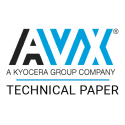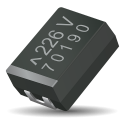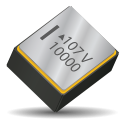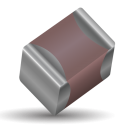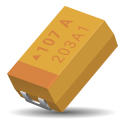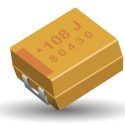LICA® Design Guide Written By: Phil Troup Abstract: A review of high frequency decoupling basics highlighting the advantages of using LICA® with its C4 terminations in these applications.
Resources
High CV Tantalum Capacitors Challenges and Limitations Written By: I.Horacek | T.Zednicek | S.Zednicek | T.Karnik | J.Petrzilek | P.Jacisko | P.Gregorova | I. Pinwill Abstract: The trend toward portable electronics is a major driving force in the need for miniaturisation of electronic components. Tantalum capacitors are becoming a product of first choice where high electrical and mechanical stability along with long service life and volumetric efficiency are demanded. The latest generation of ultra-high surface area tantalum powders in combination with an efficient constructional and encapsulation system provides a new solution for the next generation of component downsizing. This paper describes the main challenges and limitations in processes and materials that have been necessary to overcome for increased capacitance and
Young’s Modulus and Thermal Diffusivity Measurements of Barium Titanate Based Dielectric Ceramics Written By: G. S. White and C. Nguyen National Bureau of Standards Gaithersburg, MD 20899 Bharat Rawal AVX Corporation Myrtle Beach, SC 29577 Abstract: Young’s modulus and thermal diffusivity values have been obtained on a set of barium titanate based ceramics using ultrasonic pulseecho and photoacoustic effect (PAE) measurements. The PAE was shown to detect variations in thermal diffusivity between materials of varying composition and processing treatments. The results are valuable in the evaluation of dielectric ceramic materials for practical electronics applications.
Hermetically Sealed 230°C MnO2 Tantalum Capacitors Written By: T. Zednicek | M. Biler | J. Petrzilek | I. Pinwill Abstract: Certain electronic applications, such as oil and gas exploration drilling, are continuously demanding ever higher operating temperatures. Recently operating temperature requirements have increased from 200°C to 230°C with an increased operating life from hours to one thousand hours and beyond. This need is linked with the continuous development of oil drilling heads and sensors and their use for deeper drilling or drilling in more difficult geological conditions. Capacitors with high capacitance value are a common part of the electronic boards used in these applications, but over 125°C/175°C, available capacitor choice is very limited. Tantalum SMD capacitor technology has proved its
Surface Mount Soldering Techniques and Thermal Shock in Multilayer Ceramic Capacitors Written By: John Maxwell Abstract: All components used in surface mount assemblies have temperature processing limitations that must be adhered to for maximum reliability. This paper discusses multilayer ceramic capacitors in detail and soldering process considerations that are valid for all SMT components.
Some Observations on Recent MLCCs Quality as Experienced in Europe Including Discussion of Two Types of Dpa Analysis Written By: Dr. Phil Ward Abstract: A study of the European MLC quality by two types of DPA analysis shows that the newer formulations of 2F4 (Z5U) are as reliable as C0G (NP0) and 2C1 (X7R) formulations. These newer 2F4 formulations have small grain structure and low porosity which perform excellent on life test at 2xRV and load humidity 85ºC/85% RH at RV.
Reliability of MLCCs After Thermal Shock Written By: Bharat S. Rawal | Michael Childs | Allan Cooper | Bill McLaughlin Abstract: With increasing use of multilayer ceramic capacitors in surface mount applications, the understanding of thermal shock properties of these devices is becoming increasingly important. Of the various soldering techniques utilized in surface mount applications, including wave soldering, vapor phase and infra red reflow techniques, wave soldering imposes the most severe thermal stresses on the MLCs. To simulate this process, parts are often dipped in solder baths. It will be shown in this paper that properties like critical stress intensity factor K1C, thermal diffusivity, Young’s modulus and the chip geometry are important for understanding the thermal shock behavior of chips.
Glossary Of Terms Used in the Tantalum Industry Written By: John Gill Abstract: Terms used in the tantalum industry can often be confusing to the layperson. The purpose of this paper is to allow someone to look up any terms of which he or she is unsure. It is directed at the reader of technical literature in particular.
Reliability and Characterization of MLCC Decoupling Capacitors With C4 Interconnections Written By: Donald Scheider | Donald Hopkins | Paul Zucco | Edward Moszczynski | Michael Griffin | Mark Takacs IBM Microelectronics Division Hudson Valley Research Park 1580 Rte. 52, Hopewell Jct., NY 12533 John Galvagni AVX Corporation 2200 AVX Drive Myrtle Beach, SC 29577 Abstract: Multilayer ceramic (MLC) capacitors are composite structures made of alternating layers of ceramic (dielectric material) and metal (electrodes). The dielectric material is barium titanate-based ceramic and the electrodes are made of platinum. C4 (controlled collapse chip connections) technology [1] is used to provide multiple attachment points to substrates. A high dielectric constant of barium titanatebased ceramic helps to achieve a large capacitance/size ratio. The capacitance
Parameters Important For Surface Mount Applications Of Multilayer Ceramic Capacitors Written By: Bharat S. Rawal | Kumar Krishnamani | John Maxwell Abstract: With increasing use of multilayer ceramic capacitors (MLCs) in surface mount technology (SMT), the understanding of the mechanical properties and thermal stress resistance parameters of MLCs is essential for zero defect soldering and sub ppm failure rates. In this paper, various aspects of SMT including zero defect design, placement considerations, soldering techniques, thermal stress resistance parameters, and post solder handling are reviewed. Special emphasis is given to parameters responsible for thermal shock behavior of MLCs with review of the effect of overall component thickness, temperature gradients, and terminations of MLCs.
Multilayer Ceramic Capacitors Materials and Manufacture Written By: Manfred Kahn Abstract: The economical mass production of highquality, reliable and low-cost multilayer ceramic (MLC) capacitors requires a thorough understanding of the characteristics of the materials used, a knowledge of chemistry and electronics, as well as a high level of expertise in mechanical-equipment design and in-process technology.
Low-Voltage Performance of Multilayer Ceramic Capacitors Written By: N. H. Chan and B. S. Rawal Abstract: Extensive experiments and detailed analyses of the performance of multilayer ceramic capacitors used for decoupling and in other low-voltage, low-impedance applications discloses no degradation of insulation resistance in components without physical flaws. Capacitors with physical flaws show similar loss of performance at both low and high voltages.
Cracks: The Hidden Defect Written By: John Maxwell Abstract: Cracks in ceramic chip capacitors can be introduced at any process step during surface mount assembly. Thermal shock has become a “pat” answer for all of these cracks, but about 75 to 80% originate from other sources. These sources include pick and place machine centering jaws, vacuum pick up bit, board depanelization, unwarping boards after soldering, test fixtures, connector insulation, final assembly, as well as defective components. Each source has a unique signature in the type of crack that it develops so that each can be identified as the source of error.
Equivalent Series Resistance of Tantalum Capacitors Written By: R.W. Franklin Abstract: The resistive losses which occur with all practical forms of capacitor are made up from several different mechanisms, including resistance in components and contacts, viscous forces within the dielectric and defects producing bypassing current paths. To express the effect of these various factors on the behavior of an electrolytic capacitor they are lumped together as one term, the equivalent series resistance (ESR).
Conduction and Failure Mechanisms in Barium Titanate Based Ceramics Under Highly Accelerated Conditions Written By: B. S. Rawal and N. H. Chan Abstract: Various mid-K and high-K barium titanate based laboratory compositions were studied to understand the conduction and failure mechanisms in multilayer ceramic capacitors (MLCs). These studies were utilized to establish the failure modes, the cause of failures, and determine the voltage and temperature acceleration factors. Current voltage plots were evaluated to study the endurance of the various ceramics under stress. These observations were employed to develop test conditions to screen commercial parts with one to two orders of magnitude lower failure rates and study production processes and types of ceramic materials to further improve the reliability of MLCs
Surface Mount Ceramic Resonators Written By: Phil Elliott Abstract: Ceramic resonators provide an attractive alternative to quartz crystals for oscillation frequency stabilization in many applications. Their low cost, mechanical ruggedness and small size often outweigh the reduced precision to which frequencies can be controlled, when compared to quartz devices. Ceramic resonators are now available in surface mountable packages suitable for automated production processes.
